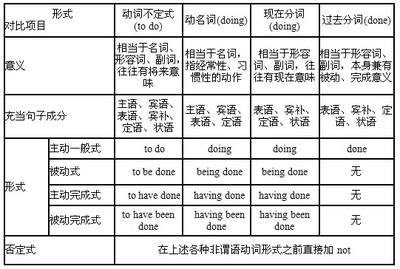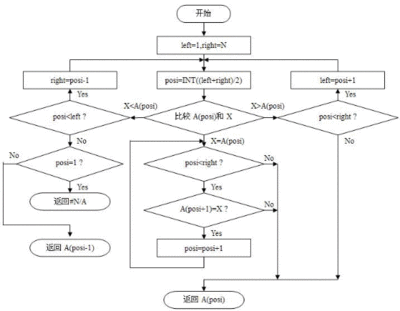非谓语动词经典用法讲解
★命题规律
1.考查立意较低,主要考查的是非谓语的一些最基本的用法。但是,题目的设置注重了情景化和结构复杂化,加大了考生对题干句的理解难度。
2.设问的角度呈现出多样化趋势,不仅仅是非谓语间的互相干扰。
★命题趋势
不容置疑,高考将继续加强对非谓语动词的考查,试题的特征将继续呈现出“情景化”和“设问角度的多样化”的趋势,但试题的难度将会有所控制。
★解题思路
① 解析句子结构,确定设空在句子中充当的功能(如状语、定语或宾补);
② 找准相关动词的逻辑主语,确定该动词与逻辑主语是什么关系(主动还是被动);
③ 搜索句子中相关的时间信息,确定非谓语动词的恰当形式;
④ 将该选项置入空中,看是否能够做到字从意顺,或是否能传达有效信息、完成交际任务。
★分词、不定式作宾补用法要点
一、分词、不定式作宾语补足语的区别
1.感官动词see, watch, observe, look at, hear, listen to, notice等和使役动词have 后面的宾补有三种形式,即原形动词(不带to的不定式)、现在分词和过去分词。现在分词表主动或正在进行,过去分词表被动或完成,动词原形表主动和完成。如:
I heard her sing an English song just now.
刚才我听见她唱了一首英文歌。
I heard her singing an English song when I passed by her roomyesterday.
昨天经过她房间时,我听见她在唱英文歌。
I heard the English song sung many times.
我多次听到有人唱这首英文歌。
注意:不及物动词的过去分词作宾补表完成和状态。如:
I looked down at my neck and found my necklace gone. (状态)
I was surprised to find my hometown changed so much. (完成)
2.leave 后接三种形式作宾补时,其中的leave保留了原来之义“留下”,但表达的确切之义应是“使……处于某种状态)。
leave sb. doing sth. 让某人一直做某事(宾语和宾补之间是主谓关系,表示动作正在进行。)
leave sth. undone 留下某事未做(宾语和宾补之间是动宾关系,表示被动和完成,一般以undone,unfinished, unsettled, untouched 为多)
leave sb. to do sth. 留下某人做某事
leave sth. to be done 留下某事要做(不定式表示将来的动作。)
如:It’s wrong of you to leave the machine running.
你让机器一直开着是不对的。(主动,正在进行)
The guests left most of the dishes untouched, because theydidn’t taste delicious.
客人们没有动大部分菜,因为它们尝起来不可口。(被动,完成)
He left, leaving me to do all the rest work.
他走了,留下我一人去做剩余的工所有工作。(主动,将来)
We hurriedly ended our meeting, leaving many problems to besettled.
我们匆匆忙忙地结束了会议,留下了很多问题等待解决。(被动,将来)
3.have, get 后接三种形式作宾补时,其中have, get 表示“使、让、叫”之意。
① have sth. done = get sth. done “使/让某事由别人去做”(叫/让某人做某事)。如
I’ll have /get my bike repaired tomorrow.
此外,have sth. done 还表示“使遭受……”之意。如
Tom had his leg broken while playing football.
Mr. Smith had his house broken into while he was away onholiday.
② have sb. / sth. doing 使/让某人/物持续地做某事(现在分词表示主动,正在进行)
get sb. / sth. doing 使某人/物开始行动起来
如:The peasants had the tractor working day and night at theharvest time.
农忙时,农民们让拖拉机夜以继日地干活。
The captain got the soldiers moving toward the front after ashort rest.
休息了片刻之后,上尉让士兵们开始朝前线行进起来。
注意:“have sb. doing”若用于否定句中,其中have 有“容忍”之意。如:
I won’t have you speaking to your parents like that.
我不会让你那样子跟你的父母说话。
Don’t have the water running all the time. 不要让水流个不停。
③ have sb. do sth. (get sb. to do sth. ) 使/让/叫某人去做某事
如:Mother had me go to the shop and buy some salt.
I can’t get him to stop smoking. He won’t listen to me.
二、下列动词后跟带to 的不定式作补语:
advise, allow, ask, beg, cause, encourage, expect, forbid,force, get, intend, invite, like, love, order, persuade, prefer,require, teach, tell, want, warn, wish, 等。如:
① An army spokesman stressed that all the soldiers had beenordered to issue clear warning before firing any shots.
② The teacher asked us not to make so much noise.
③ The flu is believed to be caused by viruses that like toreproduce in the cells inside the human nose and throat.
三、不定式、现在分词作宾补小窍门
下列动词后在主动语态中用不带to 的不定式作补语,但在被动语态中要加上to:
它们是“吾看三室两厅一感觉”——5看(look at, see, watch, notice,observe);3使(make, let, have);2听(listen to,hear);1感觉(fell)。以上动词还可用现在分词作宾语补足语(5+3+2+1-2+4):即以上动词除let, make外都可以用现在分词作宾语补足语,此外find, catch, keep, have 也可以用现在分词作宾语补足语。
如:At that time, I found him crying in the street.
He was caught stealing. I’m sorry to have kept you waiting forsuch a long time.
The missing boys were last seen playing near the river.
★不定式、分词作定语用法要点
一、不定式作定语
1.作定语的不定式如果是不及物动词,或者不定式所修饰的名词或代词是不定式动作的地点、工具等,不定式后面须有相应的介词。如:
The Browns have a comfortable house to live in.
There is nothing to worry about.
Please give me a knife to cut with.
Here is some paper for you to write on.
但是,不定式所修饰的名词如果是time, place 或way时,不定式后面的介词习惯上省去。如:He had no moneyand no place to live (in).
We found a way to solve this problem (in).
2.当作定语的不定式所修饰的名词或代词是不定式动作的承受者时,不定式既可以用主动语态,也可用被动语态,但其含义有所不同。试比较:
Have you anything to send ? 你有什么东西要寄吗?(不定式to send的动作执行者是“你”)
Have you anything to be sent ? 你有什么要(我或别人)寄的东西吗?
(不定式to be sent 的动作执行者是“我”或“别人”)
3.用不定式作定语的几种情况:
不定式表将来:
I borrowed some books to read during my holiday.
用来修饰被序数词、最高级或no, all, any 等限定的中心词。如:
He was the best man to do the job.
She was the first woman to win the gold medal in the OlympicGames.
Women and children were the first to get into the lifeboats.
用来修饰的词是抽象名词时,常见的有:ability, chance, idea, fact, excuse, promise,answer, reply, attempt, belief, way, reason, moment, time 等。如:
Do you have the ability to read and write English ?
I havea chance to go sight –seeing.
二、分词作定语
1.作定语的及物动词分词形式为:V –ing; being + 过去分词;当被修饰的名词与分词为主动关系时,用V–ing;当被修饰的名词与分词为被动关系且表正在进行时,用being +过去分词;当被修饰的名词与分词为被动关系且表完成时,用过去分词。例如:
The houses being built are for the teachers.
The broken glass is Tom’s.
I have never seen a more moving movie.
2.作定语的不及物动词分词形式为:V –ing 和过去分词。V –ing 表示正在进行;过去分词表示已经完成。如:
falling leaves正落的叶子fallen leaves 落下的叶子
boiling water正沸腾的水boiled water 沸腾过的水(白开水)
三、不定式、过去分词和现在分词被动式作定语的区别
这三种形式作定语,主要是体现在动作的发生时间上。过去分词表示的动作或是在谓语所表示的动作之前发生,或是没有一定的时间性。如:
Have you read the novel written by Dickens ?
He is a man loved and respected by all.
Don’t use words, expression_r_rs, or phrases known only to peoplewith specific knowledge.
现在分词的被动式作定语时表示的动作正在发生或是与谓语动词所表示的动作同时发生。如:Listen ! The song beingsung is very popular with the students.
不定式的被动式作定语时,表示一个未来的动作。
如:The question to be discussed at the tomorrow’s meeting is avery important one.
★不定式、动名词作宾语用法要点
一、下面动词只能用不定式作宾语,请牢记下列小诗:
决心学会想希望,拒绝设法愿假装。
主动答应选计划,同意请求帮一帮。
Decide / determine, learn, want, expect / hope / wish, refuse,manage, care, pretend, offer, promise, choose, plan, agree, ask /beg, help
此外,afford, strive(斗争) 等也要用不定式作宾语。例如:
① She pretended not to see me when I passed by.
② We agreed to meet here but so far she hasn’t turned upyet.
③ In order to gain a bigger share in the international market,many state-run companies are striving to make their products morecompetitive.
二、下列动词只能用动名词作宾语,请牢记下列小诗:
考虑建议盼原谅,承认推迟没得想。避免错过继续练,否认完成停欣赏,不禁介意准逃亡。
consider / suggest / advise, look forward to, excuse, pardon,admit, delay/ put off, fancy, avoid, miss, keep / keep on,practise, deny, finish, enjoy / appreciate, can’t help, mind, allow/ permit, escape, imagine, forbid, risk
此外be used to, look forward to, lead to, devote to, stick to,object to, get down to, pay attention to, can’t stand (无法忍受), giveup, feel like, insist on, put off, thank you for, apologize for, bebusy (in), have difficulty / trouble (in), have a good / wonderful/hard time (in)等动词词组也要用动名词作宾语。
① The squirrels was lucky that they just missed beingcaught.
② I can hardly imagine Peter sailing across the Atlantic Oceanin five days.
③ I would appreciate your calling back this afternoon.
三、下列动词或词组既可以跟动名词作宾语,也可以跟不定式作宾语,但意义上有区别,要特别注意。
1. forget to do sth.忘记去做某事forgetdoing sth.忘记已经做过某事
remember to do sth.记住去做某事remember doing sth. 记得曾经做过某事
regret to do sth.后悔/遗憾去做某事regretdoing sth. 后悔做过某事
stop to do sth.停下来去做另一件事stopdoing sth. 停止做一件事情
try to do sth.努力/试图做某事try doing sth. 尝试着做某事
mean to do sth.意欲/想/企图做某事mean doing sth. 意味着做某事
go on to do sth. (做完某事)接着做另一件事 go on doing sth.继续做同一件事(=go onwith sth.)
can’t help to do sth.不能帮助做某事can’t help doing sth. 情不自禁地做某事
2.动词like, love, prefer后接不定式或动名词作宾语均可。如表示经常性的行为可用动名词,如表示具体的行为常用动词不定式。但要注意:如果like, love,prefer 前有would /should 后面则应接动词不定式。如:
I like swimming, but I don’t like to swim this afternoon.
I’d like to go swimming this weekend.
3.在动词allow, advise, forbid, permit后直接跟动名词形式作宾语,如果后面有名词或代词作宾语,其后用动词不定式作宾语补足语。即:
allow / advise /forbid / permit doing sth.
allow / advise /forbid / permit sb. to do sth.
如:We don’t allow smoking here.
We don’t allow students to smoke.
4.动词need, require, want作“需要”解时,其后必须用动名词的主动形式或不定式的被动形式作宾语,表示事情需要做。这时动名词的主动式表示被动意义。be worth后必须用动名词的主动形式表示被动意义。此外,若动词need 表“需要”,require 表“要求”,want表“想要”这些意义时,其后须接名词或代词作宾语,然后接不定式作宾语补足语。即:
need / require / want doing / to be done
need / require / want sb. to do sth.
be worth + n.(表示钱数或相当于钱数的名词)
be worthdoingbe worthy of beingdone
be worthy of + n.值得……be worthy to be done
如:The window needs / requires / wants cleaning.
The window needs / requires / wants to be cleaned.
窗户需要擦一下。
The place is worth visiting.
The place is worthy of a visit.
The place is worthy of being visited.
The place is worthy to be visited.
那个地方值得一去。
如:① only one of these books is worth reading.
② — What do you think of the book ?
— Oh, excellent, It’s worth reading a second time.
四、动词不定式作动词tell, show, understand, explain, teach, learn,advise, discuss, ask, decide, wonder, find out 等词的宾语时,前面常带wh– 引导词。即how, what, whether, where, when, who 等 + todo。但why + 不带to 的不定式。
注意此用法的不定式的逻辑主语需与主句的主语或宾语保持一致,否则用宾语从句。例如:
He showed us how to do the work. ( = He showed us how we shoulddo the work.)
I don’t know what to do. ( = I don’t know what I’ll do.)
Can you tell me why do it ?
五、动词不定式在介词but, other than 后面时,如果介词之前有行为动词do的某种形式,那么介词后的不定式不带to,否则就要带to。另外在can’t choose but,can’t help but, can’t but 后面的不定式也要省略to。如:
We could do nothing but / other than wait.
We had nothing to do but / other than wait.
We have no choice but to wait.
I can’t choose but laugh.
★不定式、分词作状语用法要点
一、不定式作状语
He sat down to have a rest. (表目的)
They went there to visit their teacher. 他们去那里拜访老师。(表目的)
He woke up only / just to find everybody gone.他醒来发现大家都走了。(表示结果)
My grandmother lived to see the liberation of China.
我祖母活到亲眼见到中国解放。(表示结果)
在某些形容词作表语,表示喜、怒、衷、乐后跟不定式表示原因。如:
I am very glad to see you. 我非常高兴地见到你。
I am so sorry to hear your mother is ill. 听到你母亲生病真遗憾。
在带有enough 或too的句子里,也常用不定式作状语,表示程度。如:
He was too excited not to say a few words.
他太激动了,不会不讲几句话的。
He is old enough to go to school. 他到上学年龄了。
She is too tired to do the job. 她太累而不能做那件工作了。
注意:强调动词不定式所表示的目的时,动词不定式可用in order to (为了) 或so as to (以便) +动词原形。so as to 不用于句首。
He got up early in order to catch the first bus.他早起为了赶上第一班车。
The bus stopped so as to pick up passengers. 汽车停下来以便接纳乘客。
To look at him, you would like him. (表条件)
To tell you the truth, I have got no money about me.
To be honest, I know nothing about it. (修饰全句,独立成分)
二、分词作状语
1.分词作状语的基本原则

分词作状语时,分词的逻辑主语必须与句子的主语保持一致。
分词作状语必须和句中主语含有逻辑上的主谓或动宾关系,否则不能使用分词作状语。
2.分词作状语的句法功能
分词或分词短语作状语时,可以表时间、原因、结果、条件、让步、行为方式、伴随状况等。表示时间关系的分词短语有时可由连词while或when 引出。如:
Hearing the news, they got excited. (时间)
Be careful while / when crossing the street. (时间)
Having been bitten by a snake, she was frightened at it.(原因)
Given a chance, I can surprise the world. (条件)
The cup dropped to the ground, breaking into pieces. (结果)
Having been told many times, he still repeated the same mistake.(让步)
The teacher came into the lab, followed by some students.(伴随状况)
3.独立成分作状语
有些分词短语,其形式的选择不受上下文的影响,称作独立成分。常见的有:
Generally speaking …一般说来Frankly speaking … 坦白地说
Judging from …根据……来判断Considering … 考虑到……
To tell you the truth … 说实话
★非谓语动词其它用法
一、疑问词 + 不定式结构
疑问词(who, which, when, where, how, what等)+不定式,这个结构在句中起名词作用,可充当主语、表语、宾语。如:
I didn’t know what to do. (宾语)
When to hold the meeting is not known yet. (主语)
My question was how to get so many books. (表语)
注意句型:Why not do sth. ? Why do sth. ?
二、不定式的主动和被动
1.不定式修饰的名词或代词和不定式逻辑上构成主谓关系时,不定式往往用主动形式。如:
Do you have a knife to cut the watermelon ? (A knife cuts thewatermelon.)
2.不定式和它前面被修饰的名词或代词构成逻辑上的动宾关系,又和该句主语构成逻辑上的主谓关系时,不定式常用主动形式。如:
She has a sister to look after. (She looks after hersister.)
I know what to do. (I do what.)
3.不定式作表语形容词的关语,和句中主语构成逻辑上的动宾关系时,不定式多用主动形式,这是因为人们往往认为形容词后省去了forsb. 。如:
This book is difficult to understand.
This kind of fish is nice to eat.
4.在there be结构中,当说话人考虑的是必须有人去完成某件事时,不定式用主动形式;如果说话人强调的事情本身必须被完成,则用被动形式。如:
There is a lot of work to do. (Someone has to do the work. )
There is a lot of work to be done. (The work has to be done.)
请注意下面两个句子的含义的不同点:
There is nothing to do. (无事可做,感到十分乏味。)
There is nothing to be done. (某东西坏了,无法使之恢复正常。)
三、不定式符号to 的保留问题
有时为了避免重复,可以用to 来代替前面的不定式,这种情况出现在下列动词之后:expect, hope, wish, mean,prefer, care, forget, want, try;或出现在be glad / happy, would like /love 等的后面。
如果在省略的不定式结构中含有:be, have, have been,这些词要保留。如:
I haven’t been to Hong Kong, but I wish to.
— Are you on holiday ?
— No, but I’d like to be.
— I didn’t tell him the news. 我没有告诉他那个消息。
— Oh, you ought to have. 噢,你本应该告诉他的
四、动名词作主语
动名词或不定式都可以在句中作主语,但在下列句型中常用动名词作主语。
It is / was no use / good + doing sth.
It is / was not any use / good + doing sth.
It is / was of little use / good + doing sth.
It is / was useless
如:It is no use crying over spilt milk. 覆水难收。
It is of little good staying up too late every day.
每天都熬夜没有什么好处
若主语和表语都是非谓语动词,应保持形式上的一致。
Seeing is believing.
To see is to believe.
眼见为实。
五、注意以下表达的意义区别
falling leaves正在下落的树叶fallen leaves 已经落下的树叶
boiling water沸腾的水boiled water 烧开过的水
developing countries发展中国家developed countries 发达国家
I like swimming, but I don’t like to swim this afternoon.
Her job is giving piano lessons to children, but this Sunday herjob is to teach the children how to dance.
The girl let out a frightened cry at the sight of the snake.(The girl was frightened. )
看到蛇,女孩尖叫起来。
His frightening shout scared the boys again.
The shout was frightening and the boys felt frightened.他大吼一声把那帮男孩给吓跑了。
类似的还有:
an exciting voice令人兴奋的声音anexcited voice 兴奋的声音
a puzzling look 令人迷惑不解的表情apuzzled look 困惑的表情
 爱华网
爱华网



